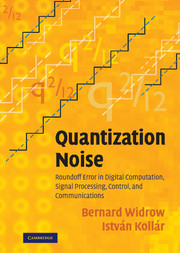 Quantization Noise
Quantization Noise Book contents
- Frontmatter
- Contents
- Preface
- Acknowledgments
- Glossary of Symbols
- Acronyms and Abbreviations
- Part I Background
- 1 Introduction
- 2 Sampling Theory
- 3 Probability Density Functions, Characteristic Functions, and Moments
- Part II Uniform Quantization
- Part III Floating–Point Quantization
- Part IV Quantization in Signal Processing, Feedback Control, and Computations
- Part V Applications of Quantization Noise Theory
- Part VI Quantization of System Parameters
- APPENDICES
- Bibliography
- Index
3 - Probability Density Functions, Characteristic Functions, and Moments
from Part I - Background
Published online by Cambridge University Press: 06 July 2010
- Frontmatter
- Contents
- Preface
- Acknowledgments
- Glossary of Symbols
- Acronyms and Abbreviations
- Part I Background
- 1 Introduction
- 2 Sampling Theory
- 3 Probability Density Functions, Characteristic Functions, and Moments
- Part II Uniform Quantization
- Part III Floating–Point Quantization
- Part IV Quantization in Signal Processing, Feedback Control, and Computations
- Part V Applications of Quantization Noise Theory
- Part VI Quantization of System Parameters
- APPENDICES
- Bibliography
- Index
Summary
The purpose of this chapter is to provide an introduction to the basics of statistical analysis, to discuss the ideas of probability density function (PDF), characteristic function (CF), and moments. Our goal is to show how the characteristic function can be used to obtain the PDF and moments of functions of statistically related variables. This subject is useful for the study of quantization noise.
PROBABILITY DENSITY FUNCTION
Figure 3.1(a) shows an ensemble of random time functions, sampled at time instant t = t1 as indicated by the vertical dashed line. Each of the samples is quantized in amplitude. A “histogram” is shown in Fig. 3.1(b). This is a “bar graph” indicating the relative frequency of the samples falling within the given quantum box. Each bar can be constructed to have an area equal to the probability of the signal falling within the corresponding quantum box at time t = t1. The sum of the areas must total to 1. The ensemble should have an arbitrarily large number of member functions. As such, the probability will be equal to the ratio of the number of “hits” in the given quantum box divided by the number of samples. If the quantum box size is made smaller and smaller, in the limit the histogram becomes fx(x), the probability density function (PDF) of x, sketched in Fig. 3.1(c).
- Type
- Chapter
- Information
- Quantization NoiseRoundoff Error in Digital Computation, Signal Processing, Control, and Communications, pp. 31 - 58Publisher: Cambridge University PressPrint publication year: 2008
